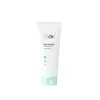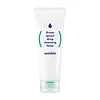What's inside
What's inside
 Key Ingredients
Key Ingredients

 Benefits
Benefits

 Concerns
Concerns

No concerns
 Ingredients Side-by-side
Ingredients Side-by-side

Water
Skin ConditioningGlycerin
HumectantSodium Cocoyl Glycinate
CleansingSodium Lauroyl Glutamate
1,2-Hexanediol
Skin ConditioningHydroxypropyl Starch Phosphate
Centella Asiatica Extract
CleansingDaucus Carota Sativa Leaf Extract
Skin ConditioningLotus Corniculatus Leaf Cell Extract
Skin ProtectingCeramide NP
Skin ConditioningCeramide As
Skin ConditioningCeramide AP
Skin ConditioningCeramide Ns
Skin ConditioningCeramide EOP
Skin ConditioningCentella Asiatica Leaf Extract
Skin ConditioningCentella Asiatica Root Extract
Skin ConditioningMadecassoside
AntioxidantMadecassic Acid
Skin ConditioningAsiaticoside
AntioxidantAsiatic Acid
Skin ConditioningCoral Powder
AbrasiveAzadirachta Indica Leaf Extract
Skin ConditioningTheobroma Cacao Extract
Skin ConditioningMacrocystis Pyrifera Extract
Skin ConditioningEclipta Prostrata Leaf Extract
Skin ConditioningLavandula Angustifolia Extract
Skin ConditioningAlthaea Officinalis Leaf Extract
Skin ConditioningOcimum Basilicum Flower/Leaf Extract
TonicRosmarinus Officinalis Leaf Extract
AntimicrobialHouttuynia Cordata Extract
Skin ConditioningAnthemis Nobilis Flower Extract
MaskingEel Extract
HumectantHydrogenated Lecithin
EmulsifyingLauryl Betaine
CleansingButylene Glycol
HumectantSodium Chloride
MaskingDecylene Glycol
Skin ConditioningDipropylene Glycol
HumectantBeta-Glucan
Skin ConditioningGlyceryl Stearate
EmollientDextrin
AbsorbentSaccharomyces Ferment Filtrate
HumectantCholesterol
EmollientFructooligosaccharides
HumectantHydrolyzed Hyaluronic Acid
HumectantHydroxyacetophenone
AntioxidantEthylhexylglycerin
Skin ConditioningPentylene Glycol
Skin ConditioningTocopherol
AntioxidantWater, Glycerin, Sodium Cocoyl Glycinate, Sodium Lauroyl Glutamate, 1,2-Hexanediol, Hydroxypropyl Starch Phosphate, Centella Asiatica Extract, Daucus Carota Sativa Leaf Extract, Lotus Corniculatus Leaf Cell Extract, Ceramide NP, Ceramide As, Ceramide AP, Ceramide Ns, Ceramide EOP, Centella Asiatica Leaf Extract, Centella Asiatica Root Extract, Madecassoside, Madecassic Acid, Asiaticoside, Asiatic Acid, Coral Powder, Azadirachta Indica Leaf Extract, Theobroma Cacao Extract, Macrocystis Pyrifera Extract, Eclipta Prostrata Leaf Extract, Lavandula Angustifolia Extract, Althaea Officinalis Leaf Extract, Ocimum Basilicum Flower/Leaf Extract, Rosmarinus Officinalis Leaf Extract, Houttuynia Cordata Extract, Anthemis Nobilis Flower Extract, Eel Extract, Hydrogenated Lecithin, Lauryl Betaine, Butylene Glycol, Sodium Chloride, Decylene Glycol, Dipropylene Glycol, Beta-Glucan, Glyceryl Stearate, Dextrin, Saccharomyces Ferment Filtrate, Cholesterol, Fructooligosaccharides, Hydrolyzed Hyaluronic Acid, Hydroxyacetophenone, Ethylhexylglycerin, Pentylene Glycol, Tocopherol
Water
Skin ConditioningGlycerin
HumectantHydrogenated Palm Acid
Potassium Hydroxide
BufferingSodium Hyaluronate
HumectantHyaluronic Acid
HumectantHordeum Distichon Extract
Skin ProtectingTriticum Vulgare Sprout Extract
Skin ConditioningPhaseolus Radiatus Sprout Extract
HumectantBrassica Oleracea Italica Sprout Extract
EmollientGlyceryl Stearate
EmollientAcrylates/C10-30 Alkyl Acrylate Crosspolymer
Emulsion StabilisingSodium Phytate
Butylene Glycol
HumectantPolyquaternium-7
Pentylene Glycol
Skin Conditioning1,2-Hexanediol
Skin ConditioningOctanediol
Capryloyl Salicylic Acid
ExfoliatingNiacinamide
SmoothingEthylhexylglycerin
Skin ConditioningAscorbic Acid
AntioxidantSodium Benzoate
MaskingRosmarinus Officinalis Leaf Oil
MaskingWater, Glycerin, Hydrogenated Palm Acid, Potassium Hydroxide, Sodium Hyaluronate, Hyaluronic Acid, Hordeum Distichon Extract, Triticum Vulgare Sprout Extract, Phaseolus Radiatus Sprout Extract, Brassica Oleracea Italica Sprout Extract, Glyceryl Stearate, Acrylates/C10-30 Alkyl Acrylate Crosspolymer, Sodium Phytate, Butylene Glycol, Polyquaternium-7, Pentylene Glycol, 1,2-Hexanediol, Octanediol, Capryloyl Salicylic Acid, Niacinamide, Ethylhexylglycerin, Ascorbic Acid, Sodium Benzoate, Rosmarinus Officinalis Leaf Oil
Ingredients Explained
These ingredients are found in both products.
Ingredients higher up in an ingredient list are typically present in a larger amount.
1,2-Hexanediol is a synthetic liquid and another multi-functional powerhouse.
It is a:
- Humectant, drawing moisture into the skin
- Emollient, helping to soften skin
- Solvent, dispersing and stabilizing formulas
- Preservative booster, enhancing the antimicrobial activity of other preservatives
Butylene Glycol (or BG) is used within cosmetic products for a few different reasons:
Overall, Butylene Glycol is a safe and well-rounded ingredient that works well with other ingredients.
Though this ingredient works well with most skin types, some people with sensitive skin may experience a reaction such as allergic rashes, closed comedones, or itchiness.
Learn more about Butylene GlycolEthylhexylglycerin (we can't pronounce this either) is commonly used as a preservative and skin softener. It is derived from glyceryl.
You might see Ethylhexylglycerin often paired with other preservatives such as phenoxyethanol. Ethylhexylglycerin has been found to increase the effectiveness of these other preservatives.
Glycerin is already naturally found in your skin. It helps moisturize and protect your skin.
A study from 2016 found glycerin to be more effective as a humectant than AHAs and hyaluronic acid.
As a humectant, it helps the skin stay hydrated by pulling moisture to your skin. The low molecular weight of glycerin allows it to pull moisture into the deeper layers of your skin.
Hydrated skin improves your skin barrier; Your skin barrier helps protect against irritants and bacteria.
Glycerin has also been found to have antimicrobial and antiviral properties. Due to these properties, glycerin is often used in wound and burn treatments.
In cosmetics, glycerin is usually derived from plants such as soybean or palm. However, it can also be sourced from animals, such as tallow or animal fat.
This ingredient is organic, colorless, odorless, and non-toxic.
Glycerin is the name for this ingredient in American English. British English uses Glycerol/Glycerine.
Learn more about GlycerinGlyceryl Stearate is a mix of glycerin and stearic acid.
It is used to stabilize the mixing of water and oil ingredients. By preventing these ingredients from separating, it can help elongate shelf life. It can also help thicken the product's texture.
As an emollient, it helps soften skin and supports barrier-replenishing ingredients.
In cosmetics, Glyceryl Stearate is often made from vegetable oils or synthetically produced.
This ingredient may not be fungal-acne safe
Fun fact: The human body also creates Glyceryl Stearate naturally.
Learn more about Glyceryl StearatePentylene glycol is typically used within a product to thicken it. It also adds a smooth, soft, and moisturizing feel to the product. It is naturally found in plants such as sugar beets.
The hydrophilic trait of Pentylene Glycol makes it a humectant. As a humectant, Pentylene Glycol helps draw moisture from the air to your skin. This can help keep your skin hydrated.
This property also makes Pentylene Glycol a great texture enhancer. It can also help thicken or stabilize a product.
Pentylene Glycol also acts as a mild preservative and helps to keep a product microbe-free.
Some people may experience mild eye and skin irritation from Pentylene Glycol. We always recommend speaking with a professional about using this ingredient in your routine.
Pentylene Glycol has a low molecular weight and is part of the 1,2-glycol family.
Learn more about Pentylene GlycolWater. It's the most common cosmetic ingredient of all. You'll usually see it at the top of ingredient lists, meaning that it makes up the largest part of the product.
So why is it so popular? Water most often acts as a solvent - this means that it helps dissolve other ingredients into the formulation.
You'll also recognize water as that liquid we all need to stay alive. If you see this, drink a glass of water. Stay hydrated!
Learn more about Water